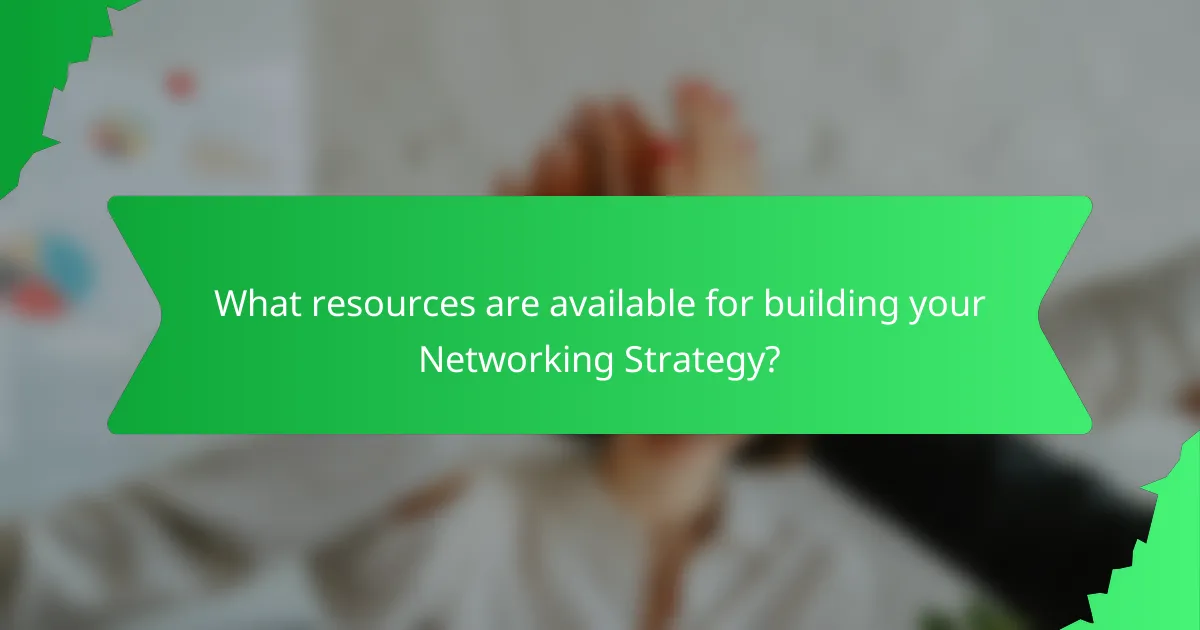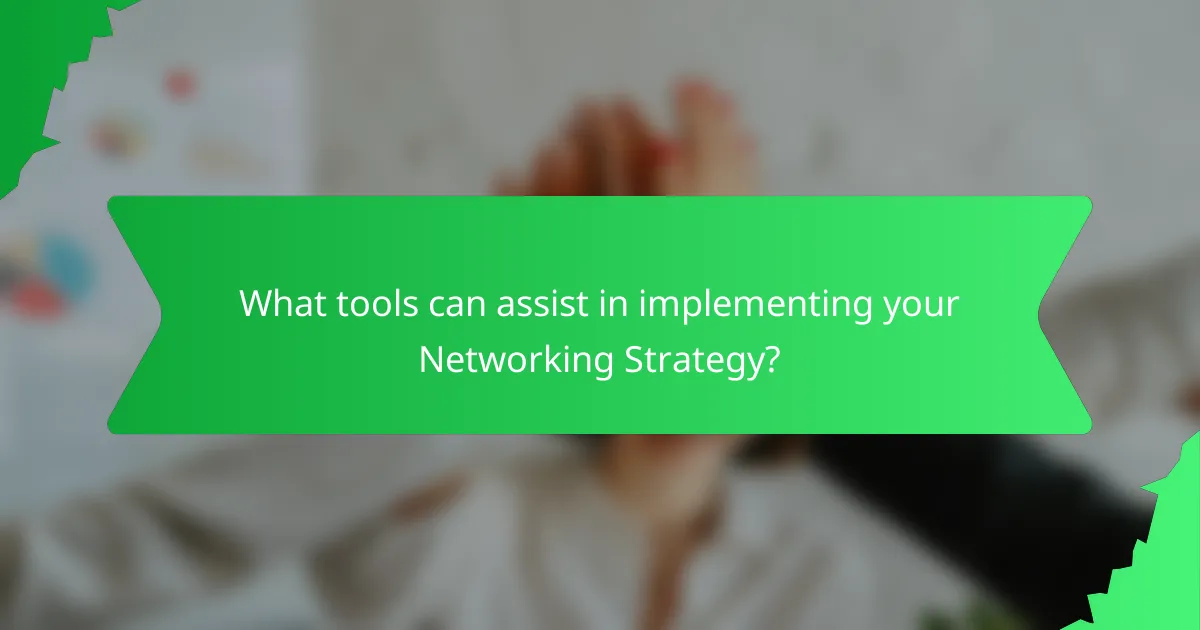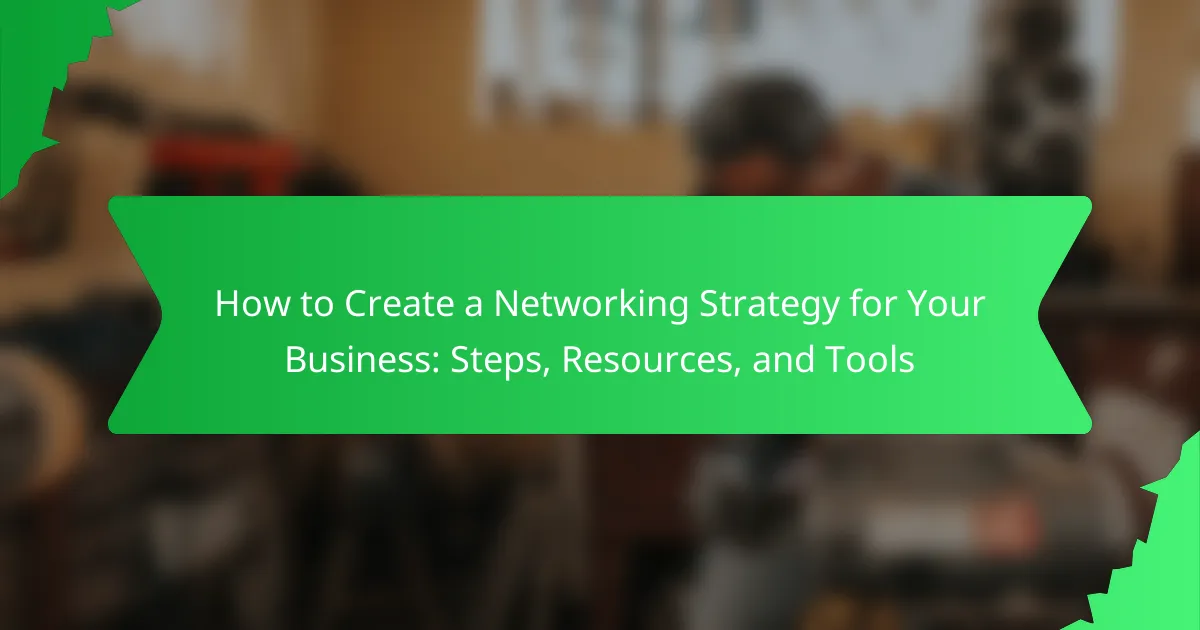A networking strategy for your business is a structured plan designed to build and maintain professional relationships that support your business goals. This article outlines the essential steps for creating an effective networking strategy, including identifying key contacts, attending relevant events, and utilizing social media platforms. It highlights the importance of networking, noting that a significant percentage of job opportunities arise from these connections. Additionally, the article discusses various resources, such as online courses, networking events, and professional associations, along with tools like CRM software and event management platforms that can enhance the implementation of a networking strategy.

What is a Networking Strategy for Your Business?
A networking strategy for your business is a structured plan to build and maintain professional relationships. This strategy focuses on connecting with individuals and organizations that can support your business goals. It involves identifying key contacts, attending relevant events, and leveraging social media platforms. A successful networking strategy enhances visibility and fosters collaborations. For instance, 70% of jobs are found through networking, highlighting its importance. Networking can lead to partnerships, referrals, and new opportunities that drive business growth.
Why is a Networking Strategy important for business growth?
A Networking Strategy is crucial for business growth because it fosters relationships that can lead to new opportunities. Effective networking allows businesses to connect with potential clients, partners, and industry influencers. According to a study by the Harvard Business Review, 70% of jobs are found through networking. This demonstrates the power of connections in driving business success. Networking can also provide access to valuable resources and insights. Engaging with others in the industry helps businesses stay informed about trends and best practices. Additionally, a strong network can enhance credibility and reputation. Overall, a well-structured Networking Strategy significantly contributes to expanding a business’s reach and influence in the market.
What are the key objectives of a Networking Strategy?
The key objectives of a Networking Strategy include building relationships, expanding reach, and enhancing collaboration. Building relationships fosters trust and support among peers and industry leaders. Expanding reach allows access to new markets and opportunities. Enhancing collaboration encourages resource sharing and innovation. These objectives collectively contribute to business growth and sustainability. Networking strategies are essential for professional development and market positioning. Effective networking can lead to partnerships that drive success.
How does a Networking Strategy differ from traditional marketing?
A Networking Strategy focuses on building relationships for mutual benefit, while traditional marketing emphasizes promoting products or services to a wider audience. Networking is often personalized and interactive, fostering trust and collaboration. Traditional marketing typically relies on one-way communication, such as advertisements and promotions. Networking strategies prioritize long-term connections over immediate sales. In contrast, traditional marketing often aims for quick conversions and measurable results. According to a study by the Harvard Business Review, networking can lead to more sustainable business growth compared to conventional marketing methods.
What are the core components of an effective Networking Strategy?
An effective networking strategy consists of clear objectives, target audience identification, relationship building, and consistent follow-up. Clear objectives guide the purpose of networking efforts. Identifying the target audience ensures connections with relevant individuals. Relationship building fosters trust and collaboration. Consistent follow-up maintains connections and opens opportunities. According to a study by the Networking Research Group, 70% of professionals attribute their career success to networking.
What roles do personal branding and reputation play?
Personal branding and reputation are crucial for professional success. They establish an individual’s identity in the marketplace. A strong personal brand communicates expertise and values. This can attract opportunities and connections. Reputation influences how others perceive trustworthiness and reliability. Studies show that 70% of employers use social media to screen candidates. A positive reputation enhances networking potential. Conversely, a negative reputation can limit opportunities and connections. Personal branding and reputation work together to shape career trajectories.
How can you identify your target networking audience?
Identify your target networking audience by defining specific characteristics. Start by assessing your business goals and objectives. Consider the demographics of your ideal clients, such as age, profession, and location. Analyze the interests and needs of your target market. Utilize social media analytics to gather data on audience engagement. Conduct surveys or interviews to gain insights directly from potential connections. Research industry trends to understand where your audience congregates. Leverage networking events and platforms that align with your target audience. This structured approach ensures you connect with relevant individuals for effective networking.
What steps should you follow to create a Networking Strategy?
Define your networking goals. Identify what you want to achieve through networking. This could include finding new clients, building partnerships, or enhancing industry knowledge.
Identify your target audience. Determine who you want to connect with in your industry. This helps focus your networking efforts on relevant individuals and groups.
Choose your networking methods. Decide how you will network. Options include attending industry events, joining professional organizations, or utilizing social media platforms.
Create a networking plan. Outline specific actions to take, such as scheduling meetings or attending events. Set timelines for achieving your networking goals.
Engage in networking activities. Actively participate in chosen networking methods. Attend events, engage online, and reach out to potential contacts.
Follow up with connections. After meeting new contacts, reach out to maintain the relationship. Send a thank-you note or schedule a follow-up meeting.
Evaluate your networking strategy. Regularly assess the effectiveness of your networking efforts. Adjust your approach based on what works and what doesn’t.
How do you set specific goals for your Networking Strategy?
To set specific goals for your Networking Strategy, define clear objectives that align with your business needs. Identify the key outcomes you want to achieve, such as increasing contacts or enhancing brand visibility. Use the SMART criteria: goals should be Specific, Measurable, Achievable, Relevant, and Time-bound. For instance, aim to connect with 10 new industry professionals within three months. Regularly review your progress to adjust your strategy as needed. This structured approach ensures that your networking efforts are focused and effective.
What methods can you use to establish connections?
To establish connections, you can utilize several effective methods. Networking events are a prime opportunity to meet new contacts. Attending industry conferences allows for face-to-face interactions with peers. Social media platforms, like LinkedIn, facilitate online networking. Joining professional organizations provides access to a wider network. Volunteering for community events can help build relationships organically. Participating in workshops or seminars enables skill-sharing and connection-building. Following up with contacts via email or messages solidifies initial interactions. Each method fosters relationship development and enhances professional networks.

What resources are available for building your Networking Strategy?
Resources available for building your networking strategy include online courses, networking events, and professional associations. Online courses offer structured learning on networking techniques and strategies. Websites like Coursera and LinkedIn Learning provide valuable content. Networking events allow for direct interaction with industry professionals. Attending local meetups or conferences can expand your connections. Professional associations, such as the American Marketing Association, provide networking opportunities and resources. Additionally, social media platforms like LinkedIn facilitate networking by connecting professionals. These resources collectively enhance your networking strategy.
What online tools can enhance your networking efforts?
Online tools that can enhance networking efforts include LinkedIn, Meetup, and Slack. LinkedIn is a professional networking platform where users can connect with industry peers and showcase their expertise. According to LinkedIn’s data, over 700 million professionals use the platform for networking and job opportunities. Meetup facilitates in-person and virtual events, allowing users to meet like-minded individuals based on shared interests. Slack is a communication tool that enables collaboration within teams and communities, fostering connections through channels and direct messaging. Each tool serves distinct purposes that contribute to effective networking strategies.
How can social media platforms be utilized for networking?
Social media platforms can be utilized for networking by connecting professionals and facilitating interactions. Users can create profiles that showcase their skills and experiences. They can join groups relevant to their industry for discussions and knowledge sharing. Engaging with content by commenting and sharing enhances visibility. Sending direct messages can initiate one-on-one conversations. Networking events and webinars hosted on these platforms provide opportunities for live interaction. According to a report by LinkedIn, 70% of professionals were hired at a company where they had a connection. This highlights the effectiveness of social media in building professional relationships.
What networking events should you consider attending?
You should consider attending industry conferences. These events provide valuable networking opportunities with peers and leaders in your field. Trade shows are also beneficial, as they showcase the latest products and services. Workshops offer hands-on learning and networking with like-minded individuals. Local meetups can foster community connections and collaboration. Networking events hosted by professional organizations are great for building relationships. Online webinars and virtual networking events have become increasingly popular, allowing for broader participation. Each of these events can enhance your professional network and open doors for collaboration.
What offline resources can support your Networking Strategy?
Offline resources that can support your networking strategy include business cards, local networking events, and workshops. Business cards provide a tangible way to share contact information. They help establish a professional image and facilitate follow-ups. Local networking events allow for face-to-face interactions with potential contacts. These events often feature industry-specific discussions and opportunities to connect with like-minded professionals. Workshops provide skill development while also offering networking opportunities. Participants can meet others in their field and exchange ideas. Additionally, community organizations often host gatherings that encourage networking among local businesses. These offline resources enhance relationship-building and expand professional networks effectively.
How do professional associations contribute to networking?
Professional associations contribute to networking by providing platforms for members to connect with peers and industry leaders. These associations often host events such as conferences, seminars, and workshops. At these events, members can engage in face-to-face interactions. This fosters relationship-building and collaboration opportunities. Additionally, associations may offer online forums and discussion groups. These digital spaces allow for ongoing communication and knowledge sharing. Research indicates that 70% of jobs are found through networking, highlighting the importance of these connections. Furthermore, members gain access to exclusive resources and information that can enhance their professional growth.
What role do mentorship programs play in networking?
Mentorship programs play a crucial role in networking by facilitating connections between experienced professionals and mentees. These programs create structured opportunities for individuals to build relationships within their industry. Mentors often introduce mentees to their professional networks, expanding their contacts. This can lead to job opportunities, collaborations, and partnerships. A study by the Association for Talent Development found that 75% of executives credit mentoring with their success. Additionally, mentorship fosters knowledge sharing and skill development, which enhances networking effectiveness. Overall, mentorship programs serve as a bridge to valuable connections and career advancement.

What tools can assist in implementing your Networking Strategy?
Networking strategies can be effectively implemented using several tools. Customer Relationship Management (CRM) software helps manage and analyze customer interactions. Examples include Salesforce and HubSpot, which streamline communication and track networking efforts. Social media platforms like LinkedIn facilitate professional connections and networking opportunities. Event management tools, such as Eventbrite, assist in organizing networking events. Email marketing services, like Mailchimp, enable outreach to contacts and follow-ups. Networking apps, including Meetup, connect individuals with similar interests for collaboration. These tools enhance efficiency and effectiveness in executing networking strategies.
What CRM tools are effective for managing networking contacts?
Effective CRM tools for managing networking contacts include HubSpot, Salesforce, and Zoho CRM. HubSpot offers a free tier with essential features for contact management. Salesforce is known for its robust features and customization options, catering to various business sizes. Zoho CRM provides affordable plans with automation capabilities. These tools help organize contacts, track interactions, and manage relationships efficiently. According to a survey by Capterra, 65% of businesses report improved customer relationships after implementing a CRM system.
How can networking apps facilitate connections?
Networking apps facilitate connections by providing platforms for users to meet and interact. These apps often include features such as user profiles, messaging, and event listings. Users can create profiles that showcase their skills and interests. This helps in finding like-minded individuals or professionals in similar fields. Messaging features allow for direct communication, fostering relationships. Event listings enable users to discover networking opportunities in their area. According to a survey by LinkedIn, 85% of jobs are filled through networking. This statistic highlights the importance of utilizing networking apps for career advancement.
What features should you look for in networking software?
Look for scalability, security, and user-friendly interfaces in networking software. Scalability ensures the software can grow with your business needs. Security features protect sensitive data from breaches. A user-friendly interface simplifies navigation and enhances productivity. Additionally, check for integration capabilities with existing systems. Real-time monitoring features help track network performance. Customizable reporting tools provide insights into network usage. Lastly, ensure reliable customer support is available for troubleshooting.
How can you measure the success of your Networking Strategy?
You can measure the success of your networking strategy by evaluating specific metrics. Key performance indicators (KPIs) include the number of new connections made. An increase in referrals generated is another critical metric. Tracking follow-up meetings scheduled can also indicate success. Additionally, assess the quality of relationships formed through feedback. Analyze the growth in business opportunities resulting from networking efforts. Finally, review social media engagement and interactions as a measure of outreach effectiveness. These metrics provide concrete evidence of networking strategy outcomes.
What metrics should you track to evaluate effectiveness?
To evaluate effectiveness in a networking strategy, track metrics such as engagement rate, conversion rate, and return on investment (ROI). Engagement rate measures interactions like comments and shares on social media. Conversion rate tracks how many networking contacts lead to actionable business outcomes. ROI quantifies the financial return relative to the costs of networking activities. These metrics provide clear insights into the success of networking efforts. For instance, a study by HubSpot found that companies with effective networking strategies see a 30% increase in lead generation.
How can feedback inform future networking efforts?
Feedback can significantly inform future networking efforts by providing insights into what works and what doesn’t. It allows individuals and organizations to understand the effectiveness of their networking strategies. For example, feedback can reveal preferred communication styles, key topics of interest, and the overall reception of networking initiatives. This information helps in refining approaches to better align with the target audience’s needs. Research indicates that 70% of professionals find networking more effective when they receive constructive feedback. By analyzing feedback, businesses can also identify gaps in their networking strategies and make necessary adjustments. This iterative process enhances relationship-building and increases the likelihood of achieving networking goals.
What are some best practices for maintaining your Networking Strategy?
Regularly review and update your networking strategy to ensure its relevance. Set specific networking goals aligned with your business objectives. Attend industry events consistently to foster relationships and discover opportunities. Utilize social media platforms to engage with your network actively. Follow up with contacts after initial meetings to strengthen connections. Track your networking activities and outcomes to evaluate effectiveness. Seek feedback from peers to identify areas for improvement. Stay informed about industry trends to adapt your strategy accordingly.
How often should you follow up with your contacts?
You should follow up with your contacts every 2 to 4 weeks. This frequency keeps communication active without overwhelming them. Following up too frequently can lead to annoyance. Conversely, waiting too long may cause you to be forgotten. Tailor your follow-up schedule based on the nature of your relationship. For example, closer contacts may warrant more frequent check-ins. In professional settings, maintaining regular contact fosters stronger connections. Studies show that consistent communication enhances networking effectiveness.
What strategies can help you stay relevant in your network?
Engaging consistently with your network is crucial for staying relevant. Regular communication helps maintain relationships and fosters collaboration. Attend industry events to connect with peers and stay updated on trends. Sharing valuable content on social media positions you as a knowledgeable resource. Offering assistance or insights to others strengthens your network ties. Participating in online forums or groups enhances visibility and engagement. Continuous learning and skill development keep your expertise current and relevant. Networking is a dynamic process that requires ongoing effort and adaptability.
The main entity of this article is a Networking Strategy for businesses, which is a structured plan aimed at building and maintaining professional relationships to support business goals. The article provides a comprehensive overview of the importance of networking strategies for business growth, outlining key objectives such as relationship building, expanding reach, and enhancing collaboration. It differentiates networking strategies from traditional marketing, highlights core components for effectiveness, and discusses various resources, tools, and best practices for successful implementation. Additionally, it offers insights on measuring success and maintaining relevance within a professional network.
